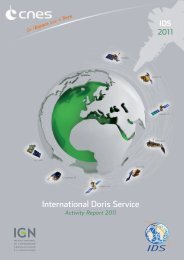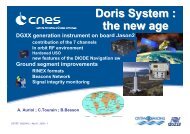ALTIKA : A MICRO-SATELLITE Ka-BAND ALTIMETRY MISSION
ALTIKA : A MICRO-SATELLITE Ka-BAND ALTIMETRY MISSION
ALTIKA : A MICRO-SATELLITE Ka-BAND ALTIMETRY MISSION
You also want an ePaper? Increase the reach of your titles
YUMPU automatically turns print PDFs into web optimized ePapers that Google loves.
Abstract.<strong>Ka</strong>-band altimetry has been proposed by Verron etal. (2001) to complement the altimetry referencemissions of the Jason class. The goal of this paper isto provide information on the so-called “Alti<strong>Ka</strong>”proposal in terms of science requirements,responsive technical specifications, and a prioriperformances. Besides the fact that the feasibility ofembarking an Alti<strong>Ka</strong> payload on a microsatellitehas already been assessed, there is also theinformation that a small launcher may have thecapability of launching several microsatellitessimultaneously (up to three) in a number ofconfigurations that may be adapted to the spacetime requirements of high resolution altimetry.IntroductionThe development of altimetry has been steady andthe benefits outstanding. There has been a quasicontinuousseries of missions, starting withGEOSAT (1985), and then ERS-1/2 (1991 and1995), and TOPEX-POSEIDON (1992). These willcontinue from Year 2000 with Jason-1 andENVISAT, that are respectively scheduled forlaunch in 2001.More generally, the heritage of past and currentoceanographic space missions has paved the way forthe incremental implementation of the spacecomponent of the Global Ocean Observing System.Because they have already demonstrated their “preoperational”maturity, in terms of end-to-endperformances, value to users and affordability,altimeter and scatterometer missions are the firstimmediate candidates for operational transition.Short-term decisions are therefore required to securecontinuity and enhancement of the current altimeterand scatterometer systems in the GODAE (GlobalOcean Data Assimilation Experiment) timeframe andbeyond.In the short term, the future looks secure with a twosatellitealtimeter system being maintained for thenext five years with Jason-1 and ENVISAT. It isforeseen that the combined use of their data withmeasurements from independent gravity missionssuch as CHAMP (2000), GRACE (2001) andpossibly GOCE (2004) will be another breakthrough.It should enable absolute estimates of ocean currents,to be obtained by subtracting an independentestimate of the geoid from individual altimeterheight measurements.A first firm decision is however needed in the veryshort term to secure continuity through Jason-2measurements in the GODAE window. Furtherdecisions will be needed to maintain a multi-satellitesystem providing the required accuracy, coverageand sampling beyond the GODAE window, after theend of life of ENVISAT. Such a system shouldprovide an affordable service equivalent to oneJason-class mission and one or two medium accuracymissions of the ENVISAT class. Several optionsneed to be evaluated, taking into account results of R& D and demonstration missions aimed at validatingnew candidate observing techniques.The goal of this paper is then to provide the readerwith the status of <strong>Ka</strong>-band altimetry, considering theembarkment of the system on a microsatelliteplatform.1. The Alti<strong>Ka</strong> proposal : about scienceobjectivesThe science objectives of the Alti<strong>Ka</strong> mission aredescribed in Verron et al. (2001) and in Remy et al.(1999) in very details.Hereafter, we only recall those of the objectives thatmost impact the design of the altimeter instrumentand the payload.1.1 Ocean Mesoscale variabilityBased on the need to resolve the mesoscalevariations and to study the effect of thesefluctuations on the energetics of the meancirculation, the spatial and temporal resolutionrequired is set by the need to directly observe themesoscale variability to a degree that allows, inconjunction with assimilative numerical models, aproper description of the oceanic eddy field and theinteractions of this field with the mean field.In 1999, G. Mitchum et al. summarized some of therequirements for a well adapted sea-surface heightsystem: The section below partly derives fromMitchum et al.’ statements concerning spacealtimetry. The constraint concerning the spatial andtemporal resolution of a sea-surface height systemmeans that we must be able to resolve signals thatoccur at spatial scales on the order of several oceanicRossby radii, and on time scales of days to weeks,which cannot presently be done with a singlealtimeter. The important question is how manyaltimeters must be available at any given time, andwhat orbits should these satellites occupy? Jacobs etal. (1999) have estimated that three altimeters areneeded to directly observe the mesoscale variationswithout additional statistical or dynamical modelinput. If assimilative models are used, however, twosatellites may be adequate. In a different set ofsimulations, Le Traon and Dibarboure (1999)






